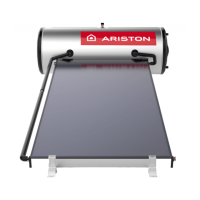PRODUCT INSTALLATION
DESCRIPTION DU PRODUIT
SYSTEM START-UP -
MISE EN FONCTION
SYSTEM STARTUP
The covering sheet must be left on the collectors until the system is nally
commissioned. This will prevent overheating and minimise the risk of burns.
The system should be lled and started up only when heat is to be extrac-
ted. Check the tightening of ange screws when the boiler is installed.
ch e c K i n G f o r l e A K S
Carry out a pressure test immediately after assembling the collectors and
piping.
• Fill the system with water using gravity only (see paragraph below)
• Increase the pressure to about 1 bar; check the hermetic seal at all con-
nections and also check that the safety valve works properly.
cl e A n i n G o f S y S t e m
Before lling the system you should remove from piping all residues that
have accumulated during production and installation. Even minute amounts
of foreign material can act as a catalyst to cause decompostion of the ther-
movector uid.
• Thoroughly rinse the entire system so as to remove all residues
• Following this, completely empty the system.
fi l l i n G o f S y S t e m
The solar system should be lled only using gravity.
Use a funnel, a rubber tube at least 3 m long, a clip and a container for pre-
paring the water-antifreeze mixture.
Push one end of the rubber tube onto the tap located in the lowest part of
the circuit, and the funnel onto the other end of the tube.
Prepare the water-antifreeze mixture and slowly pour it into the funnel.
Make sure the solar safety valve is not tted during this operation.
Once the system is full, close the lower collector tap and t the safety valve.
MISE EN FONCTION DE L’INSTALLATION
La pellicule de protection ne doit pas être retirée des capteurs jusqu’à la
mise en service dénitive an d’éviter une surchaue et de réduire au mini-
mum les risques de brûlures. L’installation ne peut être remplie et mise en
service qu’en présence d’un système d’extraction de chaleur. Contrôler le
serrage des vis de la bride au moment de l’installation du chaue-eau.
vé r i f ic At i o n d e S f u i t e S
Faire un essai sous pression immédiatement après avoir monté les capteurs
et les tuyaux.
• Remplir l’installation avec de l’eau, exclusivement par gravité (voir para-
graphe suivant).
• Augmenter la pression jusqu’à 1 bar environ ; contrôler l’étanchéité de
l’installation et de tous les raccords ainsi que le fonctionnement de la sou-
pape de sécurité.
ne t t o y A G e d e l’i n S t A l l A t i o n
Avant de remplir l’installation, tous les résidus accumulés lors de la produc-
tion et du montage devront être éliminés des tuyaux. D’inmes quantités
de corps étrangers risquent d’avoir un eet de catalyseur et de provoquer la
décomposition du uide caloporteur.
• Rincer complètement l’installation jusqu’à la totale élimination des rési-
dus.
• Vider ensuite complètement l’installation.
re m p l i S S A G e d u S y S t è m e
Le système solaire doit exclusivement être rempli par gravité.
Le remplissage nécessite un entonnoir, un tuyau en caoutchouc d’au moins
3 mètres, un collier, un bac pour préparer le mélange d’eau et d’antigel.
Fixer le tuyau au raccord du robinet situé en partie basse du circuit ; xer
l’entonnoir à l’autre extrémité du tuyau.
Après avoir préparé le mélange d’eau et d’antigel, commencer à le verser
lentement dans l’entonnoir. Pendant cette phase, la soupape de sécurité
solaire est démontée.
Le remplissage terminé, fermer le robinet au bas du capteur et monter la
soupape de sécurité.

